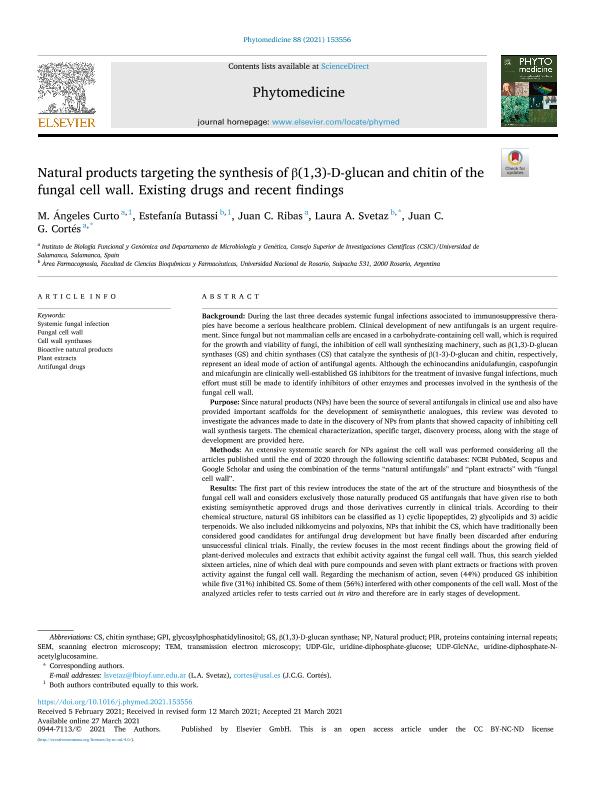Mostrar el registro sencillo del ítem
dc.contributor.author
Curto, María Ángeles
dc.contributor.author
Butassi, Estefanía

dc.contributor.author
Ribas, Juan Carlos
dc.contributor.author
Svetaz, Laura Andrea

dc.contributor.author
García Cortés, Juan Carlos

dc.date.available
2023-01-26T17:50:04Z
dc.date.issued
2021-07
dc.identifier.citation
Curto, María Ángeles; Butassi, Estefanía; Ribas, Juan Carlos; Svetaz, Laura Andrea; García Cortés, Juan Carlos; Natural products targeting the synthesis of β(1,3)-D-glucan and chitin of the fungal cell wall. Existing drugs and recent findings; Elsevier Gmbh; Phytomedicine; 88; 153556; 7-2021; 1-17
dc.identifier.issn
0944-7113
dc.identifier.uri
http://hdl.handle.net/11336/185816
dc.description.abstract
Background: During the last three decades systemic fungal infections associated to immunosuppressive therapies have become a serious healthcare problem. Clinical development of new antifungals is an urgent requirement. Since fungal but not mammalian cells are encased in a carbohydrate-containing cell wall, which is required for the growth and viability of fungi, the inhibition of cell wall synthesizing machinery, such as β(1,3)-D-glucan synthases (GS) and chitin synthases (CS) that catalyze the synthesis of β(1-3)-D-glucan and chitin, respectively, represent an ideal mode of action of antifungal agents. Although the echinocandins anidulafungin, caspofungin and micafungin are clinically well-established GS inhibitors for the treatment of invasive fungal infections, much effort must still be made to identify inhibitors of other enzymes and processes involved in the synthesis of the fungal cell wall. Purpose: Since natural products (NPs) have been the source of several antifungals in clinical use and also have provided important scaffolds for the development of semisynthetic analogues, this review was devoted to investigate the advances made to date in the discovery of NPs from plants that showed capacity of inhibiting cell wall synthesis targets. The chemical characterization, specific target, discovery process, along with the stage of development are provided here. Methods: An extensive systematic search for NPs against the cell wall was performed considering all the articles published until the end of 2020 through the following scientific databases: NCBI PubMed, Scopus and Google Scholar and using the combination of the terms “natural antifungals” and “plant extracts” with “fungal cell wall”. Results: The first part of this review introduces the state of the art of the structure and biosynthesis of the fungal cell wall and considers exclusively those naturally produced GS antifungals that have given rise to both existing semisynthetic approved drugs and those derivatives currently in clinical trials. According to their chemical structure, natural GS inhibitors can be classified as 1) cyclic lipopeptides, 2) glycolipids and 3) acidic terpenoids. We also included nikkomycins and polyoxins, NPs that inhibit the CS, which have traditionally been considered good candidates for antifungal drug development but have finally been discarded after enduring unsuccessful clinical trials. Finally, the review focuses in the most recent findings about the growing field of plant-derived molecules and extracts that exhibit activity against the fungal cell wall. Thus, this search yielded sixteen articles, nine of which deal with pure compounds and seven with plant extracts or fractions with proven activity against the fungal cell wall. Regarding the mechanism of action, seven (44%) produced GS inhibition while five (31%) inhibited CS. Some of them (56%) interfered with other components of the cell wall. Most of the analyzed articles refer to tests carried out in vitro and therefore are in early stages of development. Conclusion: This report delivers an overview about both existing natural antifungals targeting GS and CS activities and their mechanisms of action. It also presents recent discoveries on natural products that may be used as starting points for the development of potential selective and non-toxic antifungal drugs.
dc.format
application/pdf
dc.language.iso
eng
dc.publisher
Elsevier Gmbh

dc.rights
info:eu-repo/semantics/openAccess
dc.rights.uri
https://creativecommons.org/licenses/by-nc-nd/2.5/ar/
dc.subject
ANTIFUNGAL DRUGS
dc.subject
BIOACTIVE NATURAL PRODUCTS
dc.subject
CELL WALL SYNTHASES
dc.subject
FUNGAL CELL WALL
dc.subject
PLANT EXTRACTS
dc.subject
SYSTEMIC FUNGAL INFECTION
dc.subject.classification
Química Orgánica

dc.subject.classification
Ciencias Químicas

dc.subject.classification
CIENCIAS NATURALES Y EXACTAS

dc.title
Natural products targeting the synthesis of β(1,3)-D-glucan and chitin of the fungal cell wall. Existing drugs and recent findings
dc.type
info:eu-repo/semantics/article
dc.type
info:ar-repo/semantics/artículo
dc.type
info:eu-repo/semantics/publishedVersion
dc.date.updated
2022-09-20T11:04:04Z
dc.identifier.eissn
1618-095X
dc.journal.volume
88
dc.journal.number
153556
dc.journal.pagination
1-17
dc.journal.pais
Países Bajos

dc.journal.ciudad
Ámsterdam
dc.description.fil
Fil: Curto, María Ángeles. Universidad de Salamanca; España. Consejo Superior de Investigaciones Científicas; España
dc.description.fil
Fil: Butassi, Estefanía. Universidad Nacional de Rosario. Facultad de Ciencias Bioquímicas y Farmacéuticas. Departamento de Química Orgánica. Área Farmacognosia; Argentina. Consejo Nacional de Investigaciones Científicas y Técnicas. Centro Científico Tecnológico Conicet - Rosario. Centro de Estudios Fotosintéticos y Bioquímicos. Universidad Nacional de Rosario. Facultad de Ciencias Bioquímicas y Farmacéuticas. Centro de Estudios Fotosintéticos y Bioquímicos; Argentina
dc.description.fil
Fil: Ribas, Juan Carlos. Consejo Superior de Investigaciones Científicas; España. Universidad de Salamanca; España
dc.description.fil
Fil: Svetaz, Laura Andrea. Consejo Nacional de Investigaciones Científicas y Técnicas. Centro Científico Tecnológico Conicet - Rosario. Centro de Estudios Fotosintéticos y Bioquímicos. Universidad Nacional de Rosario. Facultad de Ciencias Bioquímicas y Farmacéuticas. Centro de Estudios Fotosintéticos y Bioquímicos; Argentina. Universidad Nacional de Rosario. Facultad de Ciencias Bioquímicas y Farmacéuticas. Departamento de Química Orgánica. Área Farmacognosia; Argentina
dc.description.fil
Fil: García Cortés, Juan Carlos. Consejo Superior de Investigaciones Científicas; España. Universidad de Salamanca; España
dc.journal.title
Phytomedicine

dc.relation.alternativeid
info:eu-repo/semantics/altIdentifier/url/https://www.sciencedirect.com/science/article/pii/S0944711321000982
dc.relation.alternativeid
info:eu-repo/semantics/altIdentifier/doi/https://doi.org/10.1016/j.phymed.2021.153556
Archivos asociados
